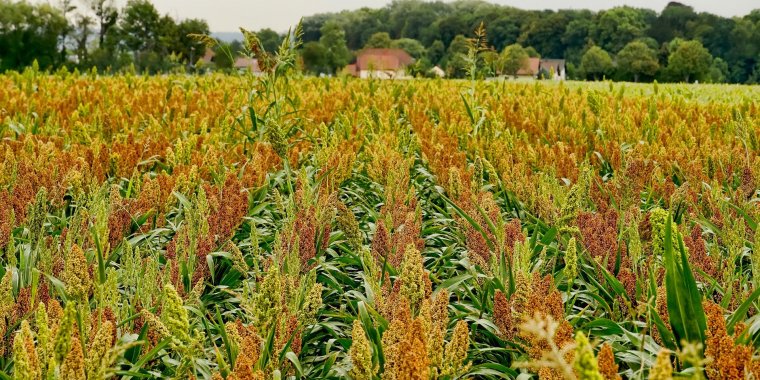| News / Science News |
Sorghum: A Sweet Proposition for Sustainable Biofuel
Sweet sorghum is best known for the amber-colored syrup that's made from its juices. Now, this hardy member of the grass family could also be tapped as a "home-grown" resource for making a renewable transportation fuel called bio-butanol.

Sorghum. Photo: Schwoaze/pixabay
Towards that end, a team of Agricultural Research Service (ARS) and Ohio State University (OSU) scientists has devised a procedure for making bio-butanol from sweet sorghum bagasse.
Bagasse refers to the pulpy, fibrous remains of the crop's stalks after they've been crushed to extract the sugary juices within.
Some bagasse is re-applied back onto crop fields; what remains can present a disposal problem. But within that pulp is a valuable cache of sugars locked within cellulose and hemicellulose—the "scaffolding" of plant cell walls.
Once freed, these cellulosic sugars can be fermented into bio-butanol, explained Nasib Qureshi, a chemical and biochemical engineer with the ARS's National Center for Agricultural Utilization Research in Peoria, Illinois.
Bio-butanol derived from cellulosic sugars in agricultural wastes is appealing because of its potential to lessen the reliance on gasoline and other nonrenewable fuels. Bio-butanol, along with ethanol, is also considered a cleaner burning alternative gasoline.
However, bio-butanol can be transported in existing pipelines and is less corrosive to internal combustion engines than ethanol. Bio-butanol also packs 33 percent more energy per gallon and is easier to blend with gasoline, said Qureshi. It also can be catalytically upgraded to bio-jet fuel (sustainable aviation fuel).
Up until the 1950s, butanol had primarily been made from the fermented sugars of cornstarch and sugarcane molasses before manufacturers switched to using petroleum, which proved cheaper and more efficient. Today, butanol is primarily used as an industrial solvent.
Over the last several years, however, Qureshi and his collaborators leveraged advances in fermentation science and product recovery technology to rekindle butanol's commercial prospects—not from petroleum, but rather a broader array of agricultural materials than had been used in the past.
In particular, the researchers set their sights on harvest or processing wastes like corn stover, barley and wheat straw, lesquerella presscake and most recently, sweet sorghum bagasse.
To help them, the researchers recruited hardy new strains of bacteria such as Clostridium beijerinckii P260 to ferment the wastes' cellulosic sugars inside specialized vats, called bioreactors.
A key advance the team made was combining what had previously been a series of separate steps into a single streamlined process—namely, the release of the wastes' cellulosic sugars, their fermentation into bio-butanol and the removal of this four-carbon alcohol (along with acetone and ethanol) from the bioreactor.
This also helps protect the hardworking bacteria inside.
In laboratory-scale experiments, the microbes produced 23 grams of bio-butanol from 160 grams of bagasse. This corresponds to production of 46 gallons of butanol from 1 ton of sweet sorghum bagasse.
Additionally, it also produces 31 gallons of acetone and ethanol per ton of this feedstock that can be used as valuable chemicals, said Qureshi.
The researchers used a solid concentrated form of bagasse (16-22 percent) that required a smaller-sized bioreactor and used about 50 percent less energy than producing bio-butanol from wheat straw, another waste they experimented with.
As a crop, sweet sorghum offers promise as a bio-butanol resource because of its drought tolerance, thrifty water uptake and adaptability to wide-ranging growing conditions, including marginal cropland. (U.S. Department of Agriculture)
YOU MAY ALSO LIKE





